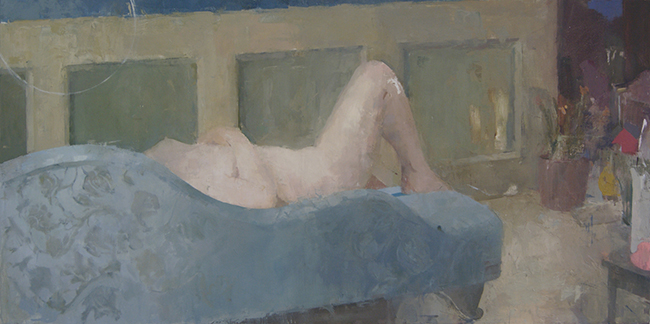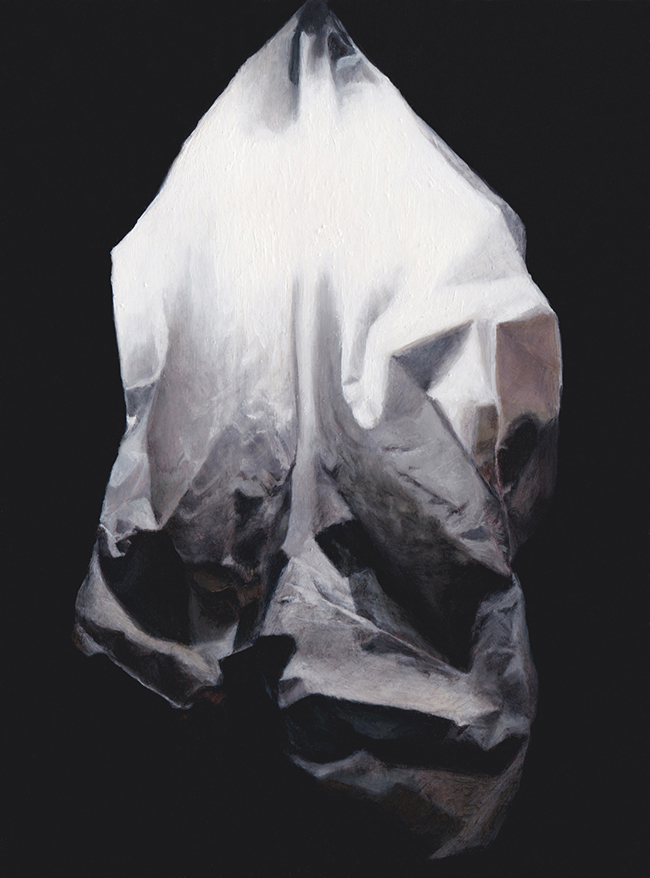by Marlene Steele
The Manifest Artist in Residency Program has been expanded to include a double position this year. The work of Jeremy Plunkett and Nicholas Anthony Mancini produced during this residency term is exhibited at the Woodburn avenue gallery.
” ‘Container’ speaks of both the act of containing and a vessel that…holds or transports something. I am a container. The subject I am always undeniably attracted to and trying to contain is light.” Excerpt from Plunkett’s artist statement
Jeremy Plunkett exhibits several postcard-sized painted surfaces mounted on deep birch brackets that explore the effects of translucency in cast or diffused light. In his artist’s statement, Plunkett describes his daily encounter with the ubiquitous plastic bag, which inspired his concept for this body of work. He has in some sense recycled these bags into art statements that depend on repetition to make his points. His depictions of the crumpled plastic dissolve into abstract gestures transforming the pocket sized surfaces into various gestures and sculpted figures abstracted by emanating, emerging or cascading light. It brought to mind the cinematic sequence of the plastic bag in the wind tunnel at the end of “American Beauty”.
The actual painting surface, though meticulous in nuance, exhibits no excitement about the process of painting. There are no revelations or aha-moments manifested in the work and these works seem to this writer devoid of interpretive paint handling. One larger work of a delicately patterned curtained window teases the viewer with its non-narrative. Plunkett states that his intention in this work is to bring the viewer into the painting.
Mancini’s title references the trace mark or visible sign left by something that’s vanished. On one wall, his explorations of form in large geometrically dominated spatial situations achieve both depth discerning space and abstracted flattened surface.
The frieze composition “Chaise Lounge” presents a headless female reclining before a panel pattern that marches across the painting from the the upper right. Paint is used as its own descriptive element. It is spattered, scraped, dripped and smudged across the surface, irreverently violating stated pattern and form.
Some mechanism of deconstruction of the painting surface is also employed as the woven canvas is visible on the bent knee of the figure and elsewhere scratches or sanding are evident. A 5 gallon bucket appears to have sat in the upper left corner. One almost wonders if the canvas lay discarded underfoot or beneath the process of another work currently in the limelight of the artist’s attention.
Spots of color notes, pink, coral and antwerp blue, with no interpretive form, animate the far right vertical area suggesting a still life.
In another work “Morning’s Trumpet”, the volume of the space is built on the abstraction of a shaft of light entering the format from the lower left. Within a two tone room of varying depths, the stretching form of the nude female is revealed in close valued tones. Her single foot and lower leg interrupts the light in its path to the wall. This bright rectangle, the solid abstraction of the light, dominates the painting surface with clarity and solidity while relating to other established geometrical factors in the space. The occasional linear comment or articulated cast shadow accentuate the painting surface and are not overused. A brush mark made in the very center of the painting, challenges the milky, murky volume of the recesses.
On the facing walls, visitors can experience a series of smaller works. “Faceted pitcher” is one such sketch exercise executed in oil on an impregnated paper. Mancini explores its pleasing proportions and paneled structure with the deconstructed surface approach. The pictorial space supporting this single object is formatted with several color bands including the unpainted paper with deckle edging. Only the red one registers as a horizontal surface with the cast shadow anchoring the pitcher.
Mancini also paints a series of mugs in various formats, on a table, in a microwave and a sugar bowl. These no-frill object exercises are interesting to contemplate as developmental painting episodes which possibly aided the painter in working out his surface technique.
Also of interest to the reader may be the interviews with both Residents published in Aeqai: March 2014
Marlene Steele teaches and paints in Cincinnati Ohio.






